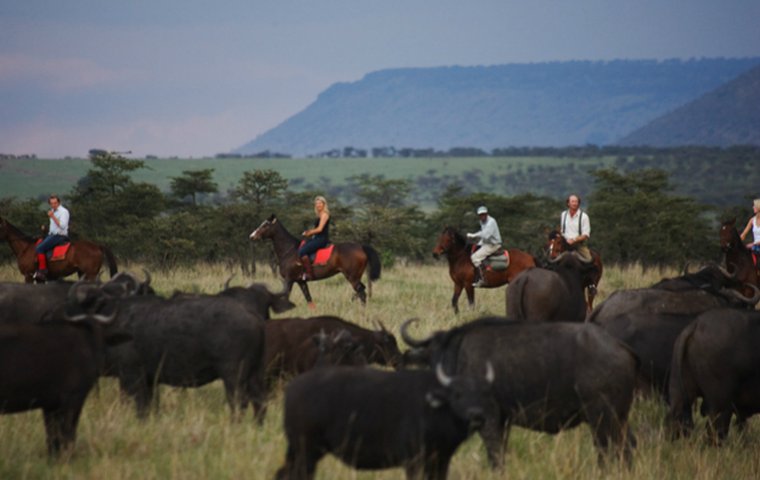
Bay, chestnut, and gray, all 14 of them stood in a straight line, ears forward, alert and ready to run. Some stood still, poised. Others fidgeted in place, shifting their weight impatiently and ready to bolt, all listening to the sounds in the early dawn. These horses were not staring down the stretch from the starting gate during a schooling session at the racetrack. They were listening to two lionesses and their pride circle and drag down a wildebeest about 100 yards from Gordie and Felicia Church’s Safaris Unlimited Masai Mara camp in the savannah near Narok in west central Kenya. Not far from the Tanzania border and the famous Serengeti Plain, these horses, many of them retired racehorses, were to be our mounts for our upcoming nine-day horseback safari. They stood tied to a picket line trusting the Masai guards, who had only bonfires, spears, and solar powered floodlights to protect all of us — horses and humans alike — from the predators circling our Olare Lamun encampment.
The preceding afternoon, a group of eight of us from Prospect, Kentucky had flown in from Nairobi, jetlagged and a little jarred and jostled by the chartered bush plane’s rough landing on the dirt runway at the Oleseki airstrip just inside the Naboisho Conservancy. Everyone in the group had owned and had ridden retired racehorses at one time or another, and we shared an appreciation for their ability to be retrained for second careers. Among us were event riders, foxhunters, former trainers and exercise riders, a saddle horse competitor, and a newly converted dressage rider. None of us were aware of just what these 14 horses would be asked to do in the next nine days. We would soon find out.
After “tea” in the English tradition on the afternoon of our arrival, we were assigned horses that would take us about 125 miles northwest, through the Ol Kinyei Conservancy and across the Mara North Conservancy to our final camp on the banks of the Mara River. Our first evening’s ride was, ostensibly, to be an opportunity to acquaint ourselves with the horses and for Gordie and Felicia to assess our strengths and weaknesses as riders.
We had all filled out detailed questionnaires about our riding experience, fitness levels, weight, and height. Gordie and Felicia provided us with a little background information about our mounts while still in the “Bush Bar,” a comfortable tent adjacent to the main dining tent. It was surprising to hear from Gordie and Felicia that among the horses we were to ride were 10 former race horses aged six to 20, including a couple of stakes-performing/stakes-producing broodmares, several former polo ponies, and a former event horse.
My wife and I were assigned two bay geldings, Rio and Rip Tide, which happened to be by the same sire (the Argentinean import Pochard, who was brought to Kenya for racing and thereafter bred until the age of 30); both of these geldings were retrained using the Parelli method of natural horsemanship. A few of the horses were Thoroughbred/Somali or other crosses, including two lovely grays often ridden by the Safaris Unlimited Staff, and a Thoroughbred/warmblood cross. There was a purebred South African Boerperd horse (the only native South African breed), as well. Of our group, seven of us rode retired Thoroughbred racehorses and one of us rode a Thoroughbred/Somali cross, but from looking at his hind end on several of the long gallops across the savannah, one would never imagine there was anything but Thoroughbred blood in this gelding’s pedigree.
After the background information about the horses was provided, our grooms (syce in Swahili) were introduced. My wife and I were assisted by a very quiet and steady hand named Alfred. We then all walked out to the picket line to meet the horses who would be our companions for the next nine days. It was to be a novel experience for all of us; routine for these seasoned equine veterans of the Safari world. We were all pleasantly surprised at the calm, relaxed demeanor of the horses as we rode out that evening through the scrub and acacia forest among zebra, gazelle (both Thompson and Grants), wildebeest too numerous to count, waterbuck, impala, topi, dik-dik, vervet monkey, baboon, and giraffe. No elephant, Cape buffalo, rhino, lions, or hippos to deal with on the first ride -- mostly just the gentler grazing varieties of prey animals, kindred spirits with our four legged mounts. There was also an occasional warthog and the odd hyena or jackal lurking in the shadows. We were able to quietly approach a large family of giraffe to photograph them close up; the horses were comfortable with these elegant but nonetheless physically imposing quadrupeds, which have the strength and leverage to dispense with attacking lions with a swift and well-placed kick. Yet the giraffes were surprisingly accepting of the calm, slow moving, non-threatening horses. For the group of us from Kentucky, it was an interesting and gentle introduction to our new mounts and to the varied and plentiful wildlife on the Mara.
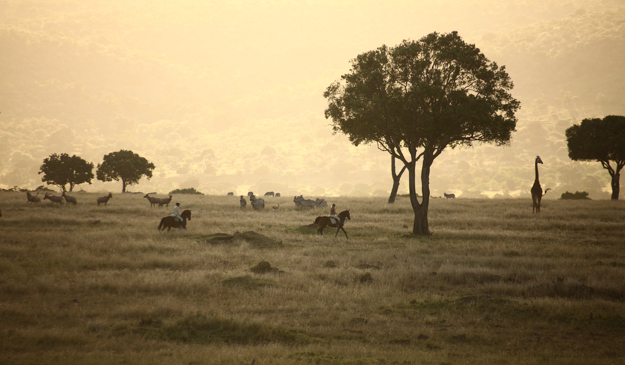
It was clear these horses knew their jobs. Grazing with bridles on and bits in mouth at every stop along the way allowed the horses to ingest valuable calories. To save strain on their backs, mounting these horses was a two person task, groom on the off side holding the stirrup while we eased into the saddle from log, stump, ant hill, or rock formation. Water holes and washes were always an opportunity for rehydration seldom wasted by these experienced veterans of the sometimes dry Mara. There was the standard midday respite for the horses to graze, tethered to a tree in a grove or in the scrub, untacked for a couple of hours for rest before moving on to the evening’s destination.
On the longest day of riding, we were in the saddle for 8 1/2 hours, covering close to 30 miles after breaking camp at 7:20 a.m. The horses demonstrated their surefootedness by safely navigating down a steep escarpment under a blustery but clear sky as we walked by their sides. The descent was followed by crossings of rain swelled washes and gullies in late morning as we progressed up a narrow valley toward a broad plain. The horses drove herds of thousands of gazelle, zebra, wildebeest, and impala up and over a ridge beyond a popular salt lick to a verdant spot under a grove of acacias, where they were rewarded with a two-hour midday break as we ate and napped. Several of these horses had adapted so well to the Mara that they wore no shoes even through this rough and sometimes rocky terrain.
As we were about to be delighted with one of the prettiest camp settings along the trek at the end of that long and physically challenging day, the horses tipped their hands by picking up their heads and pulling us hard into the Oloturoto campsite at dusk with a final burst of energy. Could they smell the fires burning or remember the lush grass in the meadow? Did they know that they did not want to be exposed to the predators after the sun set? Or were they just ready to finish the job and bury their noses in the feed bag? Did they know what Karanja, the mechanic for the large trucks used to transport the camp from one location to the next, knew? He would greet me with the admonition to remember that this camp, as lovely as it was, belonged to the lions.
As we untacked in the late golden light, Karanja’s words seemed prophetic, as a lioness appeared on the ridge about 100 yards from camp and surveyed the situation. We later learned that in the prior safari season, she had given birth to three cubs under a tree where a staff tent now stood. The Masai borrowed our field glasses to watch her and took turns gathering more wood for the bonfire that would burn all night as they stood guard over the horses and the camp. The horses, tired from their extended effort, ate and drank and stood at the picket line to rest. We next saw this lioness and part of her pride the following day sitting high on a rock ledge sunning themselves, oddly in the company of two menacing looking hyena. The horses kept a respectful distance as we photographed and observed these beautiful yet deadly cats.
The following morning, as we left camp, we encountered a large herd of Cape buffalo. The bulls in the herd weighed close to a ton and carried intimidating racks of sharp, upturned horns. The horses approached carefully, but willingly. I asked Rip Tide to move closer so that I might catch a trophy photo, but he had his limits. The message Rip had conveyed that first evening’s ride came to mind; he knew what he was doing and would take care of me. “Do not fight the Rip” was the thought he communicated when he cut loose with a huge, off the ground with all four legs, Remington Cowboy statue-like buck. I had lost a stirrup, but fortunately landed on his neck and stayed on. The entertainment inadvertently provided earned me the dubious “rider’s award” when back at the Bush Bar in camp.
In the middle of the night, weeks later, the thought came back to me -- whoever named Rip Tide knew him well. What was the well-worn advice from experienced old open ocean swimmers? “When caught in a riptide, don’t fight it. Swim with the rip until able to circle back to shore.” After that first communication sank in, I allowed Rip to do his job, and he took wonderful care of me for the next eight days -- steady and strong, no risk taking, and safely in the comfort zone.
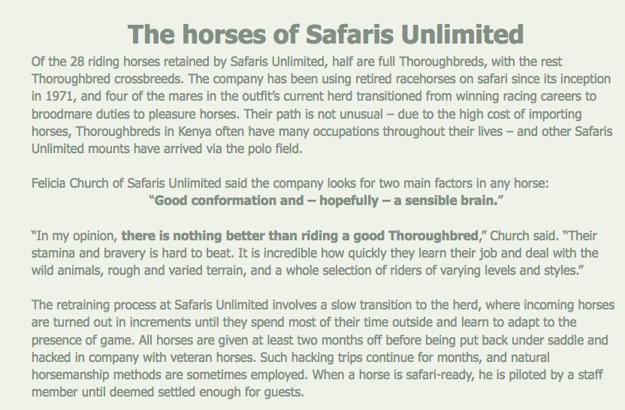
If there were ever any doubts about the versatility, stamina, and ability to remain calm and steady under pressure of these retired racehorses, the last ride of the safari dispelled them all. Our last night in camp there was a full moon glowing over the Mara River in a cool September sky. We had ridden long and hard the day before. Because it was our last day on the Mara, we were all up early as the moon still hung brilliantly above the hills to the west. We gathered on the high eastern bank of the Mara watching the hippos returning to the river after their nocturnal grazing. The horses were still tied to the picket line behind us, their faces deep in canvas feed bags. After sipping coffee by the fire and grabbing a quick breakfast, we all met with our grooms and Gordie and Felicia to mount up for the last time. Every day seemed to bring a new experience for us and a different challenge for the horses, but this final morning it was as if another few days’ worth of experiences and challenges were compressed into a few hours.
As we left camp we soon encountered another large herd of elephants loudly knocking down acacia trees to eat. The horses were unfazed and strolled by, allowing us to pause for a few final photos. Upstream a couple of miles from camp, on a big and scenic bend in the river, we came upon a group of more than five dozen hippos lying on rocks or partially submerged in the water snorting and thrashing about. The horses stood quietly in a line as we took group photos with the hippos and the Mara River as our backdrop. We jogged past a large herd of imposing Cape buffalo and up a hill to a long expanse of savannah. Gordie turned to us all and asked if we would enjoy one last gallop on the way back to camp. We all checked our girths and pulled down our hats in preparation.
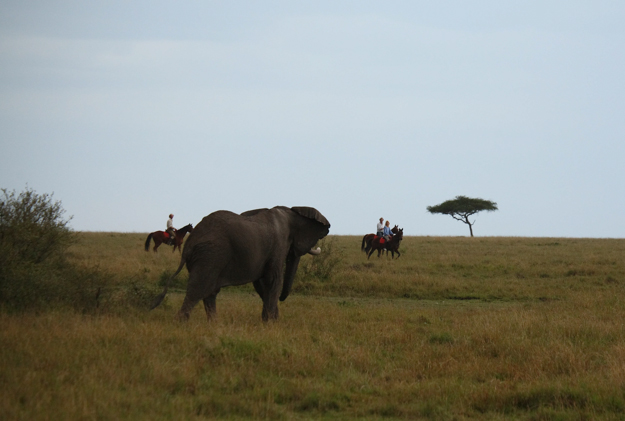
We should have known that Gordie and Felicia, who throughout the nine day trek had revealed the treasures of the Mara to us in carefully administered doses, may have saved some of the best for last. As we prepared, 11 horses and riders spread out in a line across the plain, it was apparent that nine of the horses, being retired racehorses, could sense the anticipation of the final act of this wonderful dance. The energy was palpable. As we came up over the ridge to the wide open plain between us and camp the pace quickened, Gordie raised his arm to signal the start of the gallop and we were off. We were suddenly joined on both sides by zebra, gazelle, long lines of wildebeest (some kicking up their heels in their characteristic manner), baboons screeching as they fled for the nearest trees, warthogs emerging from their holes wheeling with alarm, topi and impala scurrying, giraffe loping in the distance, and birds of prey taking flight. It was as if our mounted phalanx, 11 strong, was being dragged through the Mara, in the middle of this incredibly diverse menagerie of wild animals, by an invisible force determined to send us off in high style.
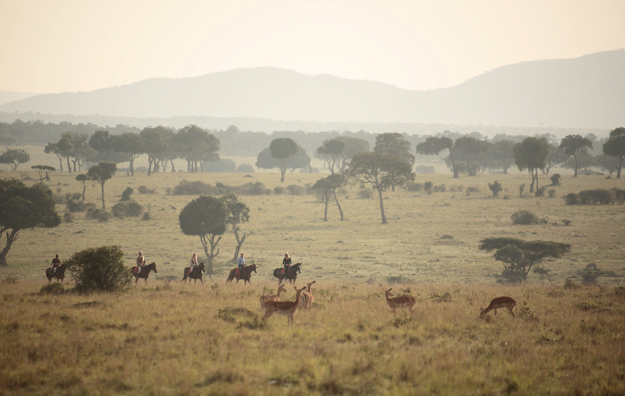
As the horses leveled out at a full gallop, the warthog holes — the uneven patches of soft ground around the anthills and the short stretches of rock — were a real concern. Miles and many hours from a real hospital, one misstep, one shying away from a wild animal coming out from behind cover, had the potential for a very unhappy ending for horse and rider. It had been, thus far, a wonderful nine day safari experience. “Stay balanced and go with the flow,” I said to myself. “Enjoy this remarkable moment.” Lesson learned, I loosened my grip on the reins and gave Rip Tide his head, and he took care of the rest. A few minutes later the other riders stood up in their stirrups and we all pulled our horses up one last time. The horses had all passed the final test, and I knew then that they had enjoyed stretching their long legs in the excitement of the moment as much as we had enjoyed the ride.
We all know that retired racehorses have proven themselves in a variety of post-racing careers. It is common now to hear stories of Thoroughbreds competing in four-star three-day events such as Rolex and Badminton. We see them playing high goal polo in Palm Beach or in the Grand Prix arena at Wellington, Florida. But in addition to the overwhelming sensory overload from the exposure to the ubiquitous and varied wildlife of the Mara, I believe we all brought home from our African horseback safari a new appreciation for the courage, intelligence, stamina, and adaptability of the Thoroughbred horse and the suitability of retired racehorses for even this very unusual second career.
---
Joel B. Turner is chair of the equine law group at the Kentucky-based law firm Frost Brown Todd LLC and is involved in a full range of equine legal services; syndicate, co-ownership, partnership and limited liability company agreements, equine lending documentation, purchase and sale agreements, private and public placements, administrative hearings and appeals, gaming regulatory matters, tax and estate planning, and litigation. He is knowledgeable in racing legislation in the United States and is actively working with horsemen throughout the country to attend to the needs of breeders, owners, and trainers.


